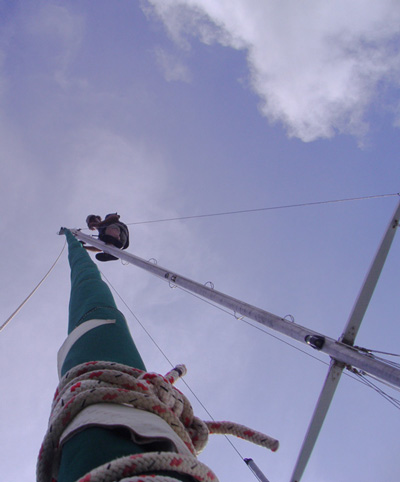Some time ago there was a book that caught a lot of people's attention (and still does) called "Sailing the Farm" by Ken Neumeyer. Mr Neumeyer proposed a very self sufficient system where a boat could sail and grow its own food (for the most part) harvest from the sea and even make your own water... The problem is that most of what he proposed simply did not work in a practical sense. While the book did have a lot of interesting tid-bits that were valuable (his information on seaweed and kelp for instance) for the most part it is a book that is best left on the shelf.
For example, his methods of making water (solar still) sounds enticing but simply is not a system that works well on boats, nor does it produce enough water for even the most water frugal cruiser and as for those with a forepeak full of tomato plants that requires watering... well it is simply not going to happen.
If you do need to search out a book on the whole self sufficient sea-steading gig you'd be much better off going with Jermome Fitzgerald's "Sea-Steading: A Life of Hope and Freedom on the Last Viable Frontier".
Speaking of solar stills department ...
Sailing Anarchy (01/18/10) had an interesting bit about a "marine" solar still by Sea Panel that bears looking into. Off hand, my experience with solar stills is that the available room on a cruising sailboat does not give you the water production needed to make it worthwhile and while the information is sketchy, I don't see anything keeping the unit from cross contamination of the the freshwater product and the saltwater which is a big problem for solar stills on boats and liferafts in anything but dead flat seas. That said, this could very well be a good investment for an emergency source of water for some scenarios and I'll be looking into it.
The exception to the rule on the cross contamination problem, would be the old GoreTex solar still that never seemed to catch on... but maybe one of our readers has some information about it?
PS... Just in from Mike at Sea Panel...
"The cross-contamination problem is mostly solved because the water in the evaporation tray does not slosh around, but is actually held inside special open cell foam, which is then wrapped in evaporative wicking material. So we get the benefit of protecting the water from slosh, and we also get the benefit of the increased efficiency of a wicking still, rather than just a passive basin still. This is covered by pending U.S. Patent.
Normally you would be correct that the water these things make is not worth the deck space, but our tests indicate that in hot weather, the Rapid Deploy Marine will make up to 2 gallons/day, which is a good rate for a 6 foot x 2.5 foot system. Plus, the unit folds up, which is good when you need the deck space but not the water."
Wednesday, January 20, 2010
On not sailing the farm and making water...maybe, maybe not!
Posted by
RLW
at
Wednesday, January 20, 2010
![]()
Labels: Books, Systems, Thought, Watermaker










